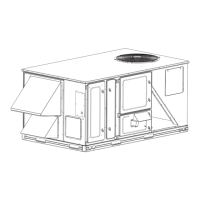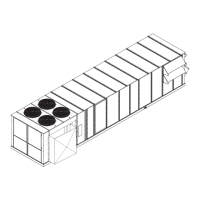30
RH1B
RH1A
RH2B
CVA
RH2A
CVB
RH2C
RH1C
CVC
LEGEND
CV -- Cooling Valve
RH -- Reheat Valve
C07008
Fig. 17 -- Humidi-- MiZer System Valve Locations
48/50PG16
C08057
Fig. 18 -- Humidi-- MiZer System Valve Locations
48/50PM16-- 28
C08608
Fig. 19 -- Humidi-- MiZer System Valve Locations
48/50PG20--28
Air Baffles
The units with Humidi-MiZert option are equipped with
Motormaster® control to maintain adequate discharge pressure for
proper unit operation during low ambient operation. This becomes
especially critical in the Reheat2 mode of operation. Wind could
have a detrimental effect depending on the orientation and the
expected design latent load of the space. If the unit is oriented with
the vertical condenser coil toward the prevailing wind, then the
field-fabricated wind baffles are required. If the unit is not oriented
as described above, but there is expected long operational periods
in the Reheat2 mode, then the field-fabricated wind baffles are
recommended. See Fig. 20 or 21 for dimensions of the
field-fabricated wind baffles.
Indoor Air Quality (IAQ)
The ComfortLink™ control has the capability for several methods
of demand ventilation control. Indoor air quality is typically
measured using a CO
2
sensor whose measurements are displayed
in parts per million (ppm). Outdoor air quality may be measured
with a CO
2
sensor for indoor-outdoor differential demand
ventilation control, or with other sensor types for the outdoor air
lockout function. The factory-installed indoor air quality CO
2
sensor is mounted in the return section. A field-installed indoor air
quality CO
2
sensor may be mounted in the return or directly in the
occupied space, per job requirements. The indoor air quality modes
of operation can be affected by configurations for indoor air quality
sensor (Configuration→AIR.Q→IA.CF), indoor air quality
switch (Configuration→AIR.Q→II.CF), outdoor air quality
sensor (Configuration→AIR.Q→OA.CF) and other related fan
and limit configurations as described below.
48/50PG and PM

